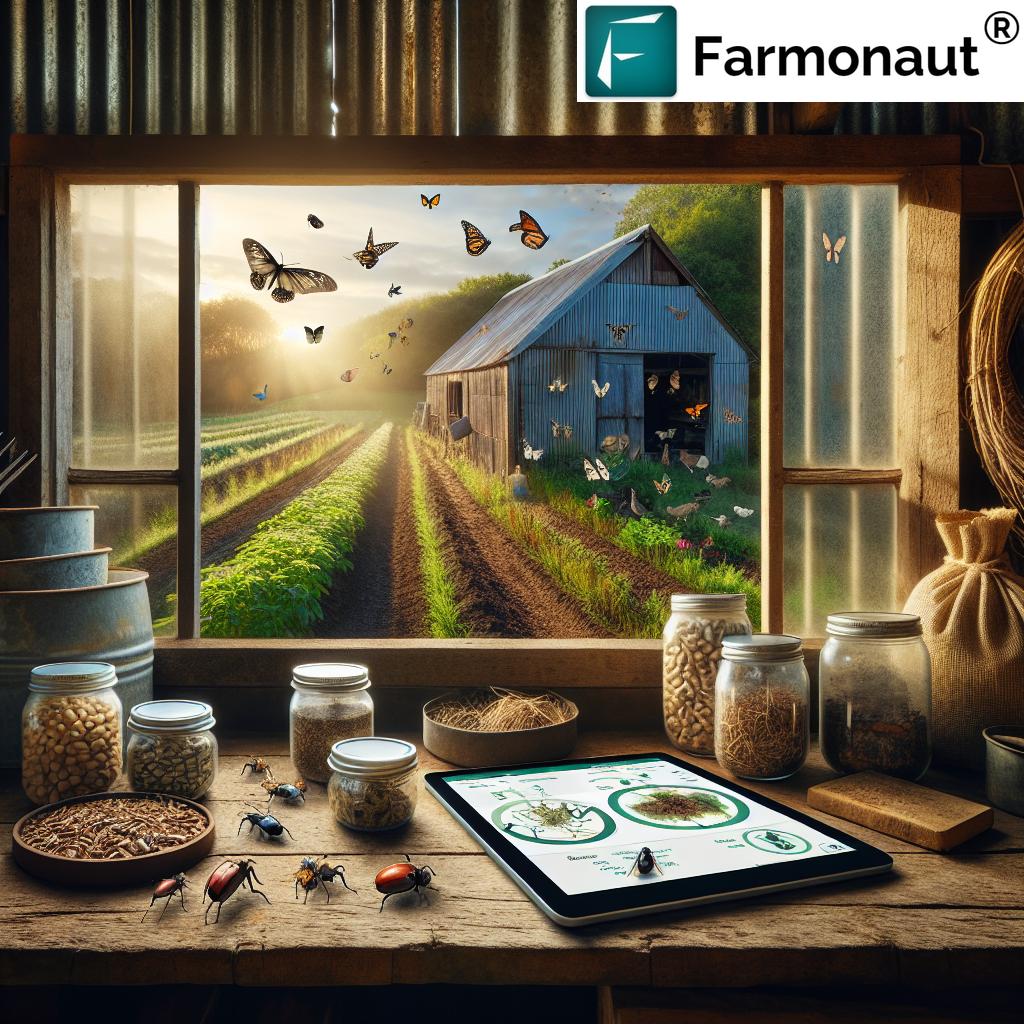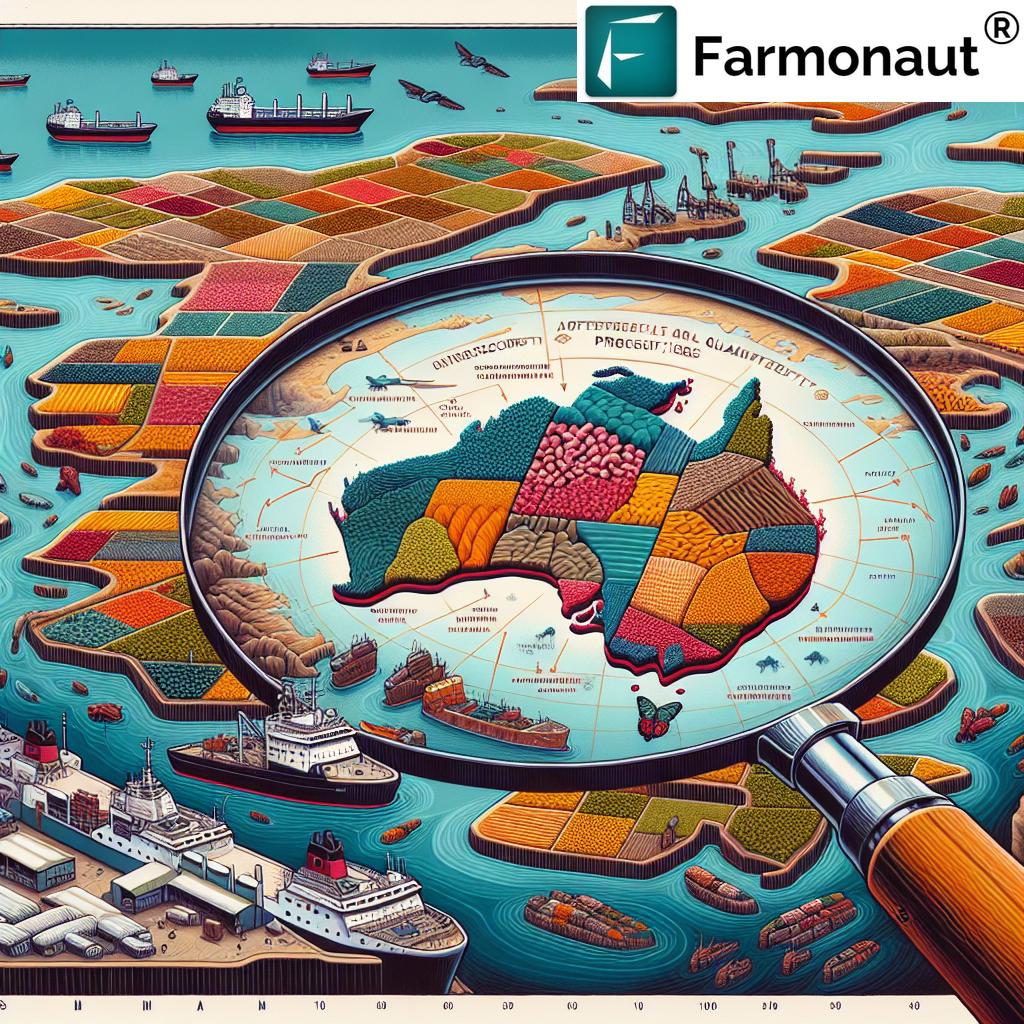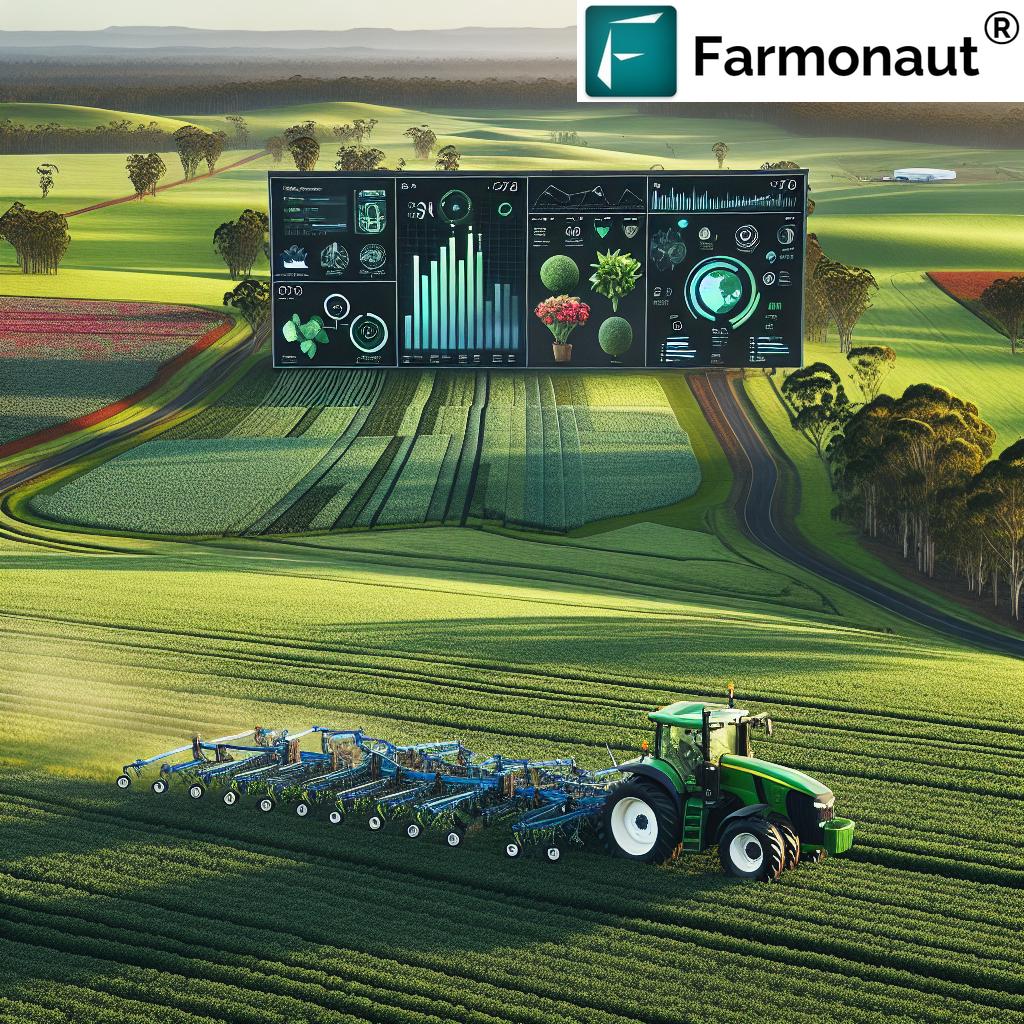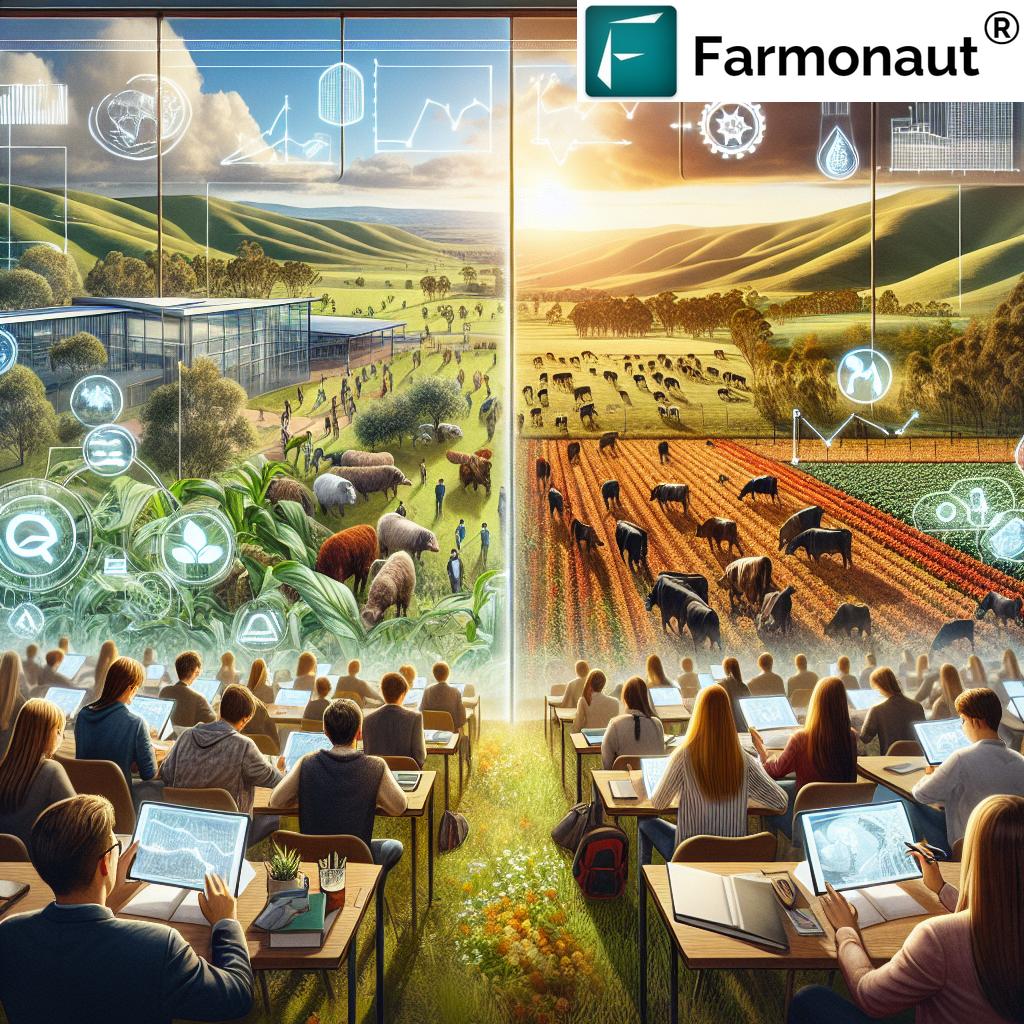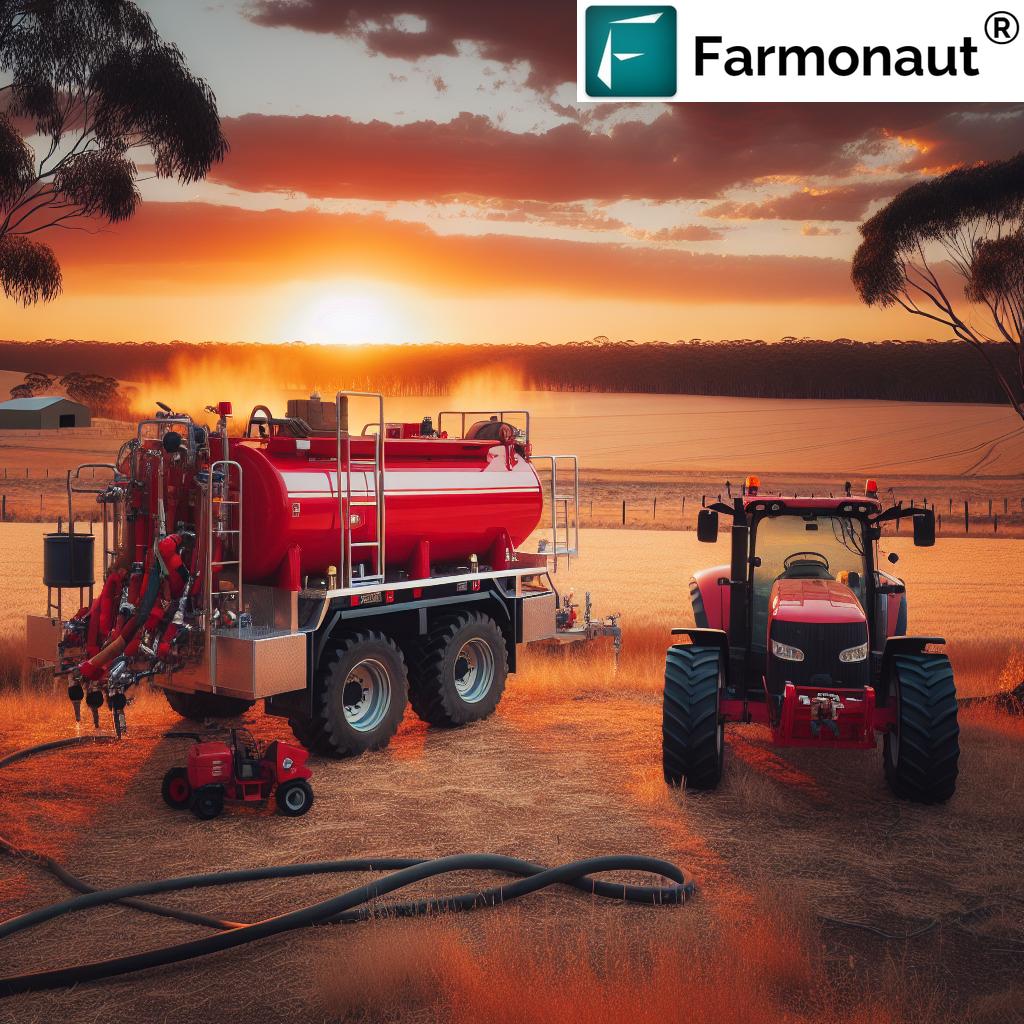From Snakes to Spiders: Navigating Farm Safety in Australia vs. Canada’s Wildlife Landscape
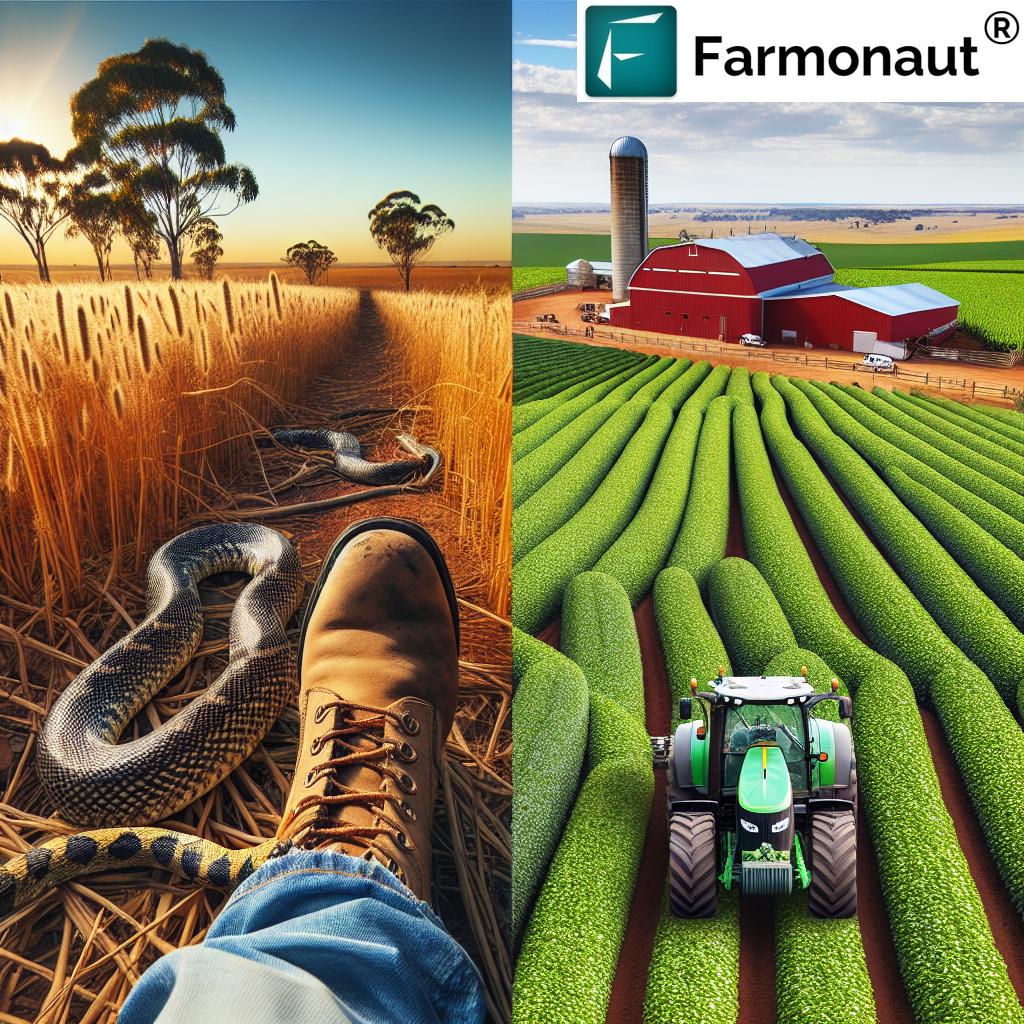
“Australia has 21 of the world’s 25 most venomous snakes, posing unique challenges for farmers compared to Canada.”
G’day, mate! Welcome to our wild ride through the fascinating world of farm safety practices and wildlife management in agriculture across two vastly different landscapes: Australia and Canada. We’re about to embark on a journey that’ll make you appreciate the unique challenges faced by farmers Down Under and their counterparts in the Great White North.
As we dive into this comparison, we’ll explore how sustainable farming techniques and agricultural technology solutions play a crucial role in both regions. From the venomous snakes lurking in the tall grass of Australian farms to the relatively tame wildlife of Southern Ontario, we’ll uncover the surprising truths about what really poses the greatest risks on farms.
The Land Down Under: Where Even the Grass Seems Dangerous
Let’s start our adventure in Australia, where farmers face a unique set of challenges that would make even the bravest Canadian farmer’s toes curl in their boots. Picture this: you’re walking through a lush field of grass, the sun beating down on your wide-brimmed hat, when suddenly you hear a rustle at your feet. In Australia, that innocent sound could be the warning sign of a deadly encounter!
Snakes on a Plain: The Slithering Menace
Australia is home to some of the world’s most venomous snakes, and they love nothing more than to hang out in farmlands. From the Eastern Brown Snake to the Inland Taipan, these reptiles pose a significant threat to farmers and livestock alike. But don’t worry, we’re not here to scare you silly – we’re here to show you how Aussie farmers have adapted to live alongside these slithery neighbors.
- Snake-proof gaiters: A fashion statement and a lifesaver
- Regular grass cutting: Keeping the playground clear for our scaly friends
- Snake awareness training: Because knowing is half the battle
One of the key farm safety practices in Australia involves constant vigilance and education. Farmers Down Under are trained to identify different snake species and understand their behaviors. It’s like a real-life game of “Snakes and Ladders,” except the stakes are much higher!
Spiders: The Eight-Legged Freaks
If snakes weren’t enough to keep you on your toes, Australia’s farms are also home to a variety of dangerous spiders. From the infamous Sydney Funnel-web to the Redback Spider, these arachnids love to hide in dark, quiet places – like that pile of hay you’re about to grab!
Crop protection strategies in Australia often include methods to deter these eight-legged invaders:
- Regular inspection of farm buildings and equipment
- Proper storage of materials to reduce hiding spots
- Use of natural predators like birds to keep spider populations in check
It’s a constant battle, but Australian farmers have learned to coexist with these critters through a combination of respect, caution, and some pretty nifty agricultural technology solutions.
Meanwhile, in the Great White North…
Now, let’s hop over to Canada, specifically Southern Ontario, where the wildlife landscape paints a very different picture. Here, farmers might be more worried about hitting a deer with their tractor than encountering a venomous creature in their fields.
The Real Dangers: Farm Equipment and Livestock
In Canada, the biggest threats to farm safety often come from within the farm itself. Farm equipment safety is paramount, as machinery accidents account for a significant portion of farm-related injuries and fatalities.
“Southern Ontario farmers face 13 times more risk from farm equipment accidents than wildlife encounters.”
- Regular maintenance of farm machinery
- Proper training for all equipment operators
- Implementation of safety protocols and emergency procedures
Canadian farmers also focus heavily on safe livestock handling. While they might not have to worry about venomous snakes, a startled cow or an aggressive bull can be just as dangerous!
The Not-So-Wild Wildlife
That’s not to say Canada doesn’t have its share of wildlife challenges. Farmers in Southern Ontario still need to be aware of:
- Coyotes and foxes preying on poultry and small livestock
- Raccoons and skunks raiding crops and causing property damage
- Deer and other large animals potentially causing road accidents
However, compared to their Australian counterparts, Canadian farmers have it relatively easy when it comes to wildlife management in agriculture. The focus here is more on humane deterrence and coexistence rather than life-or-death encounters.
Comparative Wildlife and Farm Safety Risks
| Risk Category | Australia | Canada (Southern Ontario) |
|---|---|---|
| Venomous Wildlife | High (Numerous species of venomous snakes and spiders) | Low (Few venomous species, rarely encountered) |
| Large Predators | Medium (Dingoes, crocodiles in some regions) | Low (Coyotes, occasional bears) |
| Farm Equipment Accidents | Medium | High |
| Livestock Handling Incidents | Medium | High |
| Weather-Related Hazards | High (Extreme heat, bushfires) | Medium (Severe winters, occasional storms) |
Sustainable Farming Techniques: A Global Approach
Despite their differences, both Australian and Canadian farmers are increasingly adopting sustainable farming techniques to protect their land, their livestock, and themselves. Let’s explore some of these practices:
Organic Pest Control Methods
In both countries, farmers are moving away from harsh chemicals and towards more natural solutions for pest management. This not only helps protect the environment but also reduces the risk of harmful exposure for farmers and wildlife alike.
- Companion planting to deter pests naturally
- Encouraging beneficial insects and predators
- Using physical barriers like netting and fencing
These organic pest control methods are not only effective but also contribute to a healthier ecosystem on the farm.
The Role of Fencerows in Biodiversity
Fencerows play a crucial role in maintaining biodiversity on farms in both Australia and Canada. These areas of natural vegetation along field boundaries provide habitat for beneficial insects, birds, and small mammals. They also act as natural windbreaks and help prevent soil erosion.
In Australia, fencerows can serve as fire breaks during bushfire season, while in Canada, they provide shelter for wildlife during harsh winters. It’s a win-win situation for farmers and the environment!
Embracing Agricultural Technology Solutions
As we navigate the challenges of farm safety and wildlife management, technology is playing an increasingly important role. This is where companies like Farmonaut come into the picture, offering innovative solutions to help farmers in both Australia and Canada optimize their operations and enhance safety.
Farmonaut’s satellite-based farm management solutions provide real-time insights into crop health, soil moisture levels, and other critical metrics. This technology allows farmers to make informed decisions about irrigation, fertilizer usage, and pest management, ultimately optimizing crop yields and reducing resource wastage.
The Power of Satellite Imagery
Whether you’re managing a sprawling sheep station in the Australian Outback or a dairy farm in Ontario, satellite imagery can be a game-changer. Here’s how:
- Early detection of crop stress or disease outbreaks
- Monitoring of soil moisture and nutrient levels
- Identifying areas of potential wildlife activity or damage
By leveraging these agricultural technology solutions, farmers can stay one step ahead of potential risks and challenges, whether they come from venomous creatures or unpredictable weather patterns.
AI-Powered Farm Management
Farmonaut’s Jeevn AI Advisory System takes farm management to the next level. This AI-driven tool provides personalized advice based on real-time data, helping farmers make better decisions about crop management, resource allocation, and even wildlife deterrence strategies.
Farmonaut API | API Developer Docs
For those tech-savvy farmers out there, Farmonaut also offers API access, allowing for seamless integration with other farm management tools and systems.
The Human Element: Training and Awareness
While technology plays a crucial role in modern farming, there’s no substitute for good old-fashioned human knowledge and awareness. Both Australian and Canadian farmers prioritize ongoing education and training to stay safe and productive.
Snake and Spider Safety Down Under
In Australia, farmers and farm workers undergo regular training on:
- Identifying dangerous species of snakes and spiders
- Proper first aid techniques for bites and stings
- Safe practices for working in areas where venomous creatures may be present
Equipment and Livestock Safety in Canada
Canadian farmers focus their training efforts on:
- Proper operation and maintenance of farm machinery
- Safe handling techniques for large livestock
- Weather preparedness and emergency response procedures
By combining these human-centric approaches with cutting-edge technology, farmers in both countries are creating safer, more efficient, and more sustainable agricultural practices.
Crop Protection Strategies: A Tale of Two Climates
When it comes to crop protection strategies, the vastly different climates of Australia and Canada necessitate unique approaches. Let’s take a closer look at how farmers in each country safeguard their harvests.
Australia: Battling Heat and Drought
In the land Down Under, farmers often face extreme heat and prolonged periods of drought. Their crop protection strategies focus on:
- Drought-resistant crop varieties
- Efficient irrigation systems to conserve water
- Shade cloth and other sun protection methods
Australian farmers also have to be vigilant about pests that thrive in hot, dry conditions. This is where Farmonaut’s satellite monitoring can be particularly helpful, allowing early detection of pest infestations or crop stress.
Canada: Frost Protection and Short Growing Seasons
In contrast, Canadian farmers, especially in Southern Ontario, often grapple with the threat of early frosts and relatively short growing seasons. Their crop protection strategies include:
- Frost protection methods like sprinklers and wind machines
- Selection of cold-hardy crop varieties
- Use of greenhouses and high tunnels to extend the growing season
Here too, Farmonaut’s technology can play a crucial role. By providing accurate weather forecasts and real-time crop monitoring, farmers can take proactive measures to protect their crops from sudden temperature drops.
The Unexpected Heroes: Beneficial Wildlife
While we’ve talked a lot about the dangers posed by wildlife, it’s important to remember that many animals play crucial roles in maintaining a healthy farm ecosystem. Let’s celebrate some of these unsung heroes:
Australia’s Helpful Critters
- Dung beetles: Nature’s cleanup crew, improving soil health
- Microbats: Natural pest control, consuming vast quantities of insects
- Native bees: Essential pollinators for many Australian crops
Canada’s Farm-Friendly Fauna
- Barn owls: Excellent rodent control
- Bats: Insect predators, helping to keep crop pests in check
- Earthworms: Soil aerators and organic matter processors
By understanding and encouraging these beneficial species, farmers in both countries can reduce their reliance on chemical pest control methods and promote a more balanced, sustainable farm ecosystem.
Renewable Energy on the Farm
As we consider sustainable farming techniques, we can’t overlook the growing role of renewable energy in agriculture. Both Australian and Canadian farmers are increasingly turning to green energy solutions to power their operations and reduce their environmental impact.
Solar Power: Harnessing the Sun
In sun-drenched Australia, solar power is becoming increasingly popular on farms. Solar panels can be used to:
- Power irrigation systems
- Run farm equipment and machinery
- Provide electricity for farm buildings and homes
Canadian farmers, particularly in Southern Ontario, are also embracing solar energy, taking advantage of long summer days to generate power for their operations.
Wind Energy: Blowing Away Traditional Power Sources
In both countries, wind turbines are becoming a common sight on farms, especially in areas with consistent wind patterns. These turbines can provide a significant portion of a farm’s energy needs, reducing reliance on the grid and lowering operational costs.
Farmonaut’s satellite imagery and weather forecasting capabilities can help farmers identify the best locations for solar panels and wind turbines, maximizing their renewable energy potential.
The Global Agricultural Community: Learning from Each Other
As we’ve explored the unique challenges and solutions in Australian and Canadian farming, one thing becomes clear: there’s much we can learn from each other. The global agricultural community is increasingly connected, sharing knowledge, techniques, and technologies across borders.
Platforms like Farmonaut play a crucial role in this knowledge exchange, providing farmers worldwide with access to cutting-edge agricultural technology solutions. Whether you’re dealing with venomous snakes in Sydney or winter wheat in Ontario, the principles of data-driven, sustainable farming remain the same.
Cross-Continental Collaborations
Farmers and agricultural researchers from Australia and Canada are increasingly collaborating on:
- Drought-resistant crop development
- Sustainable water management techniques
- Innovative pest control methods
These collaborations not only benefit farmers in both countries but also contribute to global food security and sustainable agricultural practices.
The Future of Farming: Safe, Sustainable, and Tech-Savvy
As we look to the future, it’s clear that farming will continue to evolve, with a growing emphasis on safety, sustainability, and technology. Whether you’re tending to sheep in the Australian Outback or managing a dairy farm in Southern Ontario, the challenges of modern agriculture require innovative solutions.
Farmonaut is at the forefront of this agricultural revolution, providing farmers with the tools they need to navigate the complexities of modern farming. From real-time crop monitoring to AI-powered advisory systems, these technologies are helping farmers around the world increase productivity, reduce risks, and promote sustainable practices.
Conclusion: Embracing the Challenges, Celebrating the Differences
As we wrap up our journey through the farms of Australia and Canada, we’re left with a deep appreciation for the resilience and ingenuity of farmers in both countries. From battling venomous creatures to navigating harsh winters, these agricultural heroes face unique challenges with courage and creativity.
The key takeaways from our exploration are:
- Farm safety is a global concern, with region-specific challenges
- Sustainable farming techniques are crucial for long-term success
- Technology plays an increasingly important role in modern agriculture
- Wildlife management requires a balanced approach
- Global collaboration and knowledge sharing drive innovation in farming
Whether you’re a farmer in Perth or Peterborough, the future of agriculture is bright, sustainable, and increasingly high-tech. With tools like Farmonaut at their disposal, farmers around the world are better equipped than ever to feed our growing population while protecting themselves, their livestock, and the environment.
So, the next time you bite into a juicy apple or enjoy a slice of bread, take a moment to appreciate the hard work, innovation, and sometimes daring adventures that went into bringing that food to your table. From the snake-dodging farmers of Australia to the frost-fighting growers of Canada, it’s all part of the rich tapestry of global agriculture.
FAQs
- Q: Are there any venomous snakes in Canada?
A: While Canada does have a few species of venomous snakes, they are much less common and generally less dangerous than those found in Australia. The most notable is the Eastern Massasauga rattlesnake, found in parts of Ontario. - Q: How do Australian farmers protect themselves from dangerous wildlife?
A: Australian farmers use a combination of protective gear (like snake-proof boots), regular property maintenance to reduce hiding spots for dangerous creatures, and ongoing education about wildlife safety. - Q: What are the main crops grown in Southern Ontario?
A: Southern Ontario is known for growing a variety of crops including corn, soybeans, wheat, fruits (like apples and grapes), and vegetables. - Q: How does climate change affect farming in Australia and Canada?
A: Climate change poses significant challenges in both countries. In Australia, it’s leading to more frequent and severe droughts and bushfires. In Canada, it’s causing more unpredictable weather patterns and potentially extending growing seasons in some areas. - Q: Can technology like Farmonaut help with wildlife management on farms?
A: Yes, Farmonaut’s satellite imagery and AI-powered analytics can help farmers identify areas of potential wildlife activity or damage, allowing for more targeted and efficient wildlife management strategies.
